Culture Mediates Climate Opinion Change: A System Dynamics Model of Risk Perception, Polarization, and Policy Effectiveness
Abstract
1. Introduction
2. Literature Review: Experience of Extreme Events Interact with Cultural, Socio-Political, and Policy Context to Shape Public Opinion
2.1. Psychological Factors: Tradeoff Between Perceived Climate Risks and Perceived Economic Costs of Mitigation
2.2. Cultural Factors: Individualistic vs. Collectivistic
2.3. Institutional Factors: Perceived Benefits and Costs of Climate Policy
2.4. Socio-Political Factors: Ideological and Affective Political Polarization
3. Research Design and Methodology
3.1. System Dynamics Model
3.2. Basic Rules of Opinion Changes and Equations
3.2.1. Relative Risk Perception: Perceived Climate Risks and Perceived Economic Costs of Mitigation
3.2.2. Social Interactions
3.2.3. Policy Effectiveness
3.2.4. Combined Model
3.3. Methods
4. Analysis Scenarios and Results
4.1. Analysis Scenarios
- (a)
- Scenario 1. Individuals in the neutral group perceive the severity of climate impacts as equal to perceived economic costs of mitigation (r = 1), with no differential effectiveness of climate and fossil fuel policies (deltaS = deltaO = 3).
- (b)
- Scenario 2. Individuals in the neutral group perceive either the severity of climate impacts or economic costs of mitigation as higher (r varies across 0.25, 0.3, 0.5, 2, 3, 4), with no differential effectiveness of climate and fossil fuel policies (deltaS = deltaO = 3).
- (c)
- Scenario 3. Individuals in the neutral group perceive either the severity of climate impacts or the economic costs of mitigation as higher (r varies across 0.25, 0.3, 0.5, 2, 3, 4), and the effectiveness of current climate and fossil fuel policies affects opinion group stability, with policy effectiveness mediating the time individuals spend in their respective opinion groups (deltaS and deltaO vary between 2, 3, 4).
4.2. Analysis Results
- (a)
- Scenario 1. The sensitivity analysis of both initial conditions for this first scenario indicates that, out of 3125 cases, there were no instances in which a dominant group changed within the next 20 years. In other words, ideological and affective polarization did not influence the switch of the dominant climate opinion group in either individualistic or collectivistic countries.
- (b)
- Scenario 2. The sensitivity analysis shows that when the opposition opinion is initially larger, 19.3% of model runs (3626 out of 18,750) resulted in the support group becoming dominant within the next 20 years. When the support opinion is initially larger, 22.0% of model runs (4125 out of 18,750) resulted in the opposition group becoming dominant within the next 20 years. The decision tree analysis for this scenario is in Figure 3.
- (c)
- Scenario 3. The sensitivity analysis shows that when the opposition opinion is initially larger, 19.3% of model runs (32,643 out of 168,750) resulted in the support group becoming dominant within the next 20 years. When the support group is initially larger, 20.1% of model runs (34,740 out of 168,750) resulted in the opposition group becoming dominant within the next 20 years. The decision tree analysis for this scenario is in Figure 4 and Figure 5.
5. Discussion
Author Contributions
Funding
Acknowledgments
Conflicts of Interest
Appendix A. Synthesized Graph of Culture, Ideological, and Affective Polarization Across Countries
Appendix A.1. Data Management
Appendix A.2. Synthesized Graph
- High ideological and affective polarization (individualistic culture): Sweden, France
- High ideological and affective polarization (mixed culture): South Korea, United States
- High ideological polarization, moderate affective polarization (individualistic culture): United Kingdom, Australia, Canada
- High ideological polarization, moderate affective polarization (mixed culture): Japan
- High ideological polarization, low affective polarization (individualistic culture): Germany
- Low ideological polarization, high affective polarization (collectivist culture): Malaysia, India, Indonesia
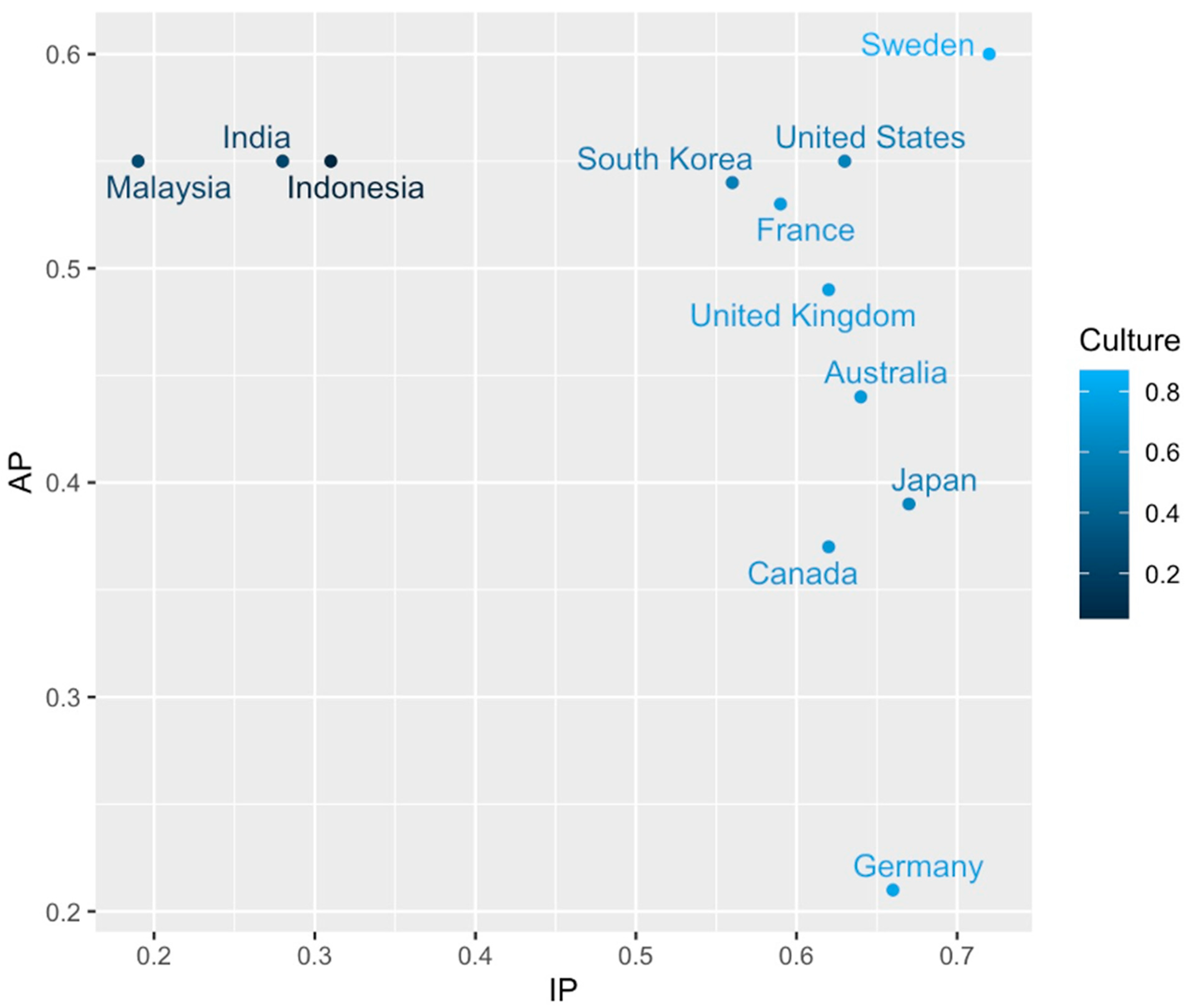
Appendix A.3. Related References to the Synthesized Graph
- Institute, E.T. Edelman Trust Barometer Global Report; Edelman Trust Institute, 2023; pp. 1–71.
- Boxell, L.; Gentzkow, M.; Shapiro, J.M. Cross-Country Trends in Affective Polarization 2021.
- Institute of Korean Studies; Shin, H.; Yang, J.; Hahm, S.D. Affective Polarization in the 2022 South Korean Presidential Election: Causes and Consequences. Korea Obs. - Inst. Korean Stud. 2024, 55, 273–296, doi:10.29152/ Edelman.2024.55.2.273.
- Carothers, T.; O’Donohue, A. Political Polarization in South and Southeast Asia: Old Divisions, New Dangers; 2020; p. 108.
Appendix B. Disclosure Elements
References
- Corfee-Morlot, J.; Maslin, M.; Burgess, J. Global Warming in the Public Sphere. Philos. Trans. Math. Phys. Eng. Sci. 2007, 365, 2741–2776. [Google Scholar] [CrossRef] [PubMed]
- Savitsky, G.; Burnett, G.; Beckage, B. Carbon, Climate, and Collapse: Coupling Climate Feedbacks and Resource Dynamics to Predict Societal Collapse. Systems 2025, 13, 727. [Google Scholar] [CrossRef]
- Zafar, S.; Ammara, S. Variations in Climate Change Views across Europe: An Empirical Analysis. J. Clean. Prod. 2024, 442, 141157. [Google Scholar] [CrossRef]
- Bromley-Trujillo, R.; Poe, J. The Importance of Salience: Public Opinion and State Policy Action on Climate Change. J. Public Policy 2020, 40, 280–304. [Google Scholar] [CrossRef]
- Schaffer, L.M.; Oehl, B.; Bernauer, T. Are Policymakers Responsive to Public Demand in Climate Politics? J. Public Policy 2022, 42, 136–164. [Google Scholar] [CrossRef]
- Hornsey, M.J.; Harris, E.A.; Bain, P.G.; Fielding, K.S. Meta-Analyses of the Determinants and Outcomes of Belief in Climate Change. Nat. Clim. Change 2016, 6, 622–626. [Google Scholar] [CrossRef]
- Doell, K.C.; Pärnamets, P.; Harris, E.A.; Hackel, L.M.; Bavel, J.J.V. Understanding the Effects of Partisan Identity on Climate Change. Curr. Opin. Behav. Sci. 2021, 42, 54–59. [Google Scholar] [CrossRef]
- Damasio, A.R. Descartes’ Error: Emotion, Reason, and the Human Brain; Grosset/Putnam: New York, NY, USA, 1994. [Google Scholar]
- Risen, J.L.; Critcher, C.R. Visceral Fit: While in a Visceral State, Associated States of the World Seem More Likely. J. Pers. Soc. Psychol. 2011, 100, 777–793. [Google Scholar] [CrossRef] [PubMed]
- North, D. Understanding the Process of Economic Change; Princeton University Press: Princeton, NJ, USA, 2005. [Google Scholar]
- Constantino, S.M.; Sparkman, G.; Kraft-todd, G.T.; Bicchieri, C.; Centola, D.; Shell-duncan, B. Scaling Up Change: A Critical Review and Practical Guide to Harnessing Social Norms for Climate Action. Psychol. Sci. Public Interes. 2022, 23, 50–97. [Google Scholar] [CrossRef]
- European Commission. Progress Report 2024: Climate Action Leading the Way—From Plans to Implementation for a Green and Competitive Europe. 2024. Available online: https://climate.ec.europa.eu/document/download/7bd19c68-b179-4f3f-af75-4e309ec0646f_en?filename=CAPR-report2024-web.pdf (accessed on 11 September 2025).
- Tyson, A.; Funk, C.; Kennedy, B. What the Data Says about Americans’ Views of Climate Change. Pew Research Center. 2023. Available online: https://www.pewresearch.org/short-reads/2023/08/09/what-the-data-says-about-americans-views-of-climate-change/ (accessed on 11 September 2025).
- Poortinga, W.; Whitmarsh, L.; Steg, L.; Böhm, G.; Fisher, S. Climate Change Perceptions and Their Individual-Level Determinants: A Cross-European Analysis. Glob. Environ. Change 2019, 55, 25–35. [Google Scholar] [CrossRef]
- Rojas, H.; Valenzuela, S. A Call to Contextualize Public Opinion-Based Research in Political Communication. Polit. Commun. 2019, 36, 652–659. [Google Scholar] [CrossRef]
- Xiang, P.; Zhang, H.; Geng, L.; Zhou, K.; Wu, Y. Individualist–Collectivist Differences in Climate Change Inaction: The Role of Perceived Intractability. Front. Psychol. 2019, 10, 187. [Google Scholar] [CrossRef]
- Chan, H.-W.; Udall, A.M.; Tam, K.-P. Effects of Perceived Social Norms on Support for Renewable Energy Transition: Moderation by National Culture and Environmental Risks. J. Environ. Psychol. 2022, 79, 101750. [Google Scholar] [CrossRef]
- Vu, T.V. Individualism and Climate Change Policies: International Evidence. J. Econ. Dev. 2023, 25, 22–36. [Google Scholar] [CrossRef]
- Borick, C.P.; Rabe, B.G. Personal Experience, Extreme Weather Events, and Perceptions of Climate Change. In Oxford Research Encyclopedia of Climate Science; Oxford University Press: Oxford, UK, 2017. [Google Scholar]
- Reser, J.P.; Bradley, G.L. The Nature, Significance, and Influence of Perceived Personal Experience of Climate Change. WIREs Clim. Change 2020, 11, e668. [Google Scholar] [CrossRef]
- Howe, P.D. Extreme Weather Experience and Climate Change Opinion. Curr. Opin. Behav. Sci. 2021, 42, 127–131. [Google Scholar] [CrossRef]
- Bohr, J. Is It Hot in Here or Is It Just Me? Temperature Anomalies and Political Polarization over Global Warming in the American Public. Clim. Change 2017, 142, 271–285. [Google Scholar] [CrossRef]
- Falkenberg, M.; Galeazzi, A.; Torricelli, M.; Marco, N.D.; Larosa, F.; Sas, M.; Mekacher, A.; Pearce, W.; Zollo, F.; Quattrociocchi, W.; et al. Growing Polarization around Climate Change on Social Media. Nat. Clim. Change 2022, 12, 1114–1121. [Google Scholar] [CrossRef]
- Cakanlar, A. Breaking Climate Change Polarization. J. Public Policy Mark. 2024, 43, 276–294. [Google Scholar] [CrossRef]
- Stanley, M.L.; Henne, P.; Yang, B.W.; Brigard, F.D. Resistance to Position Change, Motivated Reasoning, and Polarization. Polit. Behav. 2020, 42, 891–913. [Google Scholar] [CrossRef]
- Iyengar, S.; Sood, G.; Lelkes, Y. Affect, Not Ideology: A Social Identity Perspective on Polarization. Public Opin. Q. 2012, 76, 405–431. [Google Scholar] [CrossRef]
- Vasconcelos, V.V.; Constantino, S.M.; Dannenberg, A.; Lumkowsky, M.; Weber, E.; Levin, S. Segregation and Clustering of Preferences Erode Socially Beneficial Coordination. Proc. Natl. Acad. Sci. USA 2021, 118, e2102153118. [Google Scholar] [CrossRef]
- Sobkowicz, P. Opinion Dynamics Model Based on Cognitive Biases of Complex Agents. J. Artif. Soc. Soc. Simul. 2018, 21, 8. [Google Scholar] [CrossRef]
- Steiglechner, P.; Keijzer, M.A.; Smaldino, P.E.; Moser, D.; Merico, A. Noise and Opinion Dynamics: How Ambiguity Promotes pro-Majority Consensus in the Presence of Confirmation Bias. R. Soc. Open Sci. 2024, 11, 231071. [Google Scholar] [CrossRef] [PubMed]
- Dumas, M.; Rising, J.; Urpelainen, J. Political Competition and Renewable Energy Transitions over Long Time Horizons: A Dynamic Approach. Ecol. Econ. 2016, 124, 175–184. [Google Scholar] [CrossRef]
- Bury, T.M.; Bauch, C.T.; Anand, M. Charting Pathways to Climate Change Mitigation in a Coupled Socio-Climate Model. PLoS Comput. Biol. 2019, 15, e1007000. [Google Scholar] [CrossRef] [PubMed]
- Eker, S.; Reese, G.; Obersteiner, M. Modelling the Drivers of a Widespread Shift to Sustainable Diets. Nat. Sustain. 2019, 2, 725–735. [Google Scholar] [CrossRef]
- Konc, T.; Drews, S.; Savin, I.; van den Bergh, J.C.J.M. Co-Dynamics of Climate Policy Stringency and Public Support. Glob. Environ. Change 2022, 74, 102528. [Google Scholar] [CrossRef]
- Balenzuela, P.; Pinasco, J.P.; Semeshenko, V. The Undecided Have the Key: Interaction-Driven Opinion Dynamics in a Three State Model. PLoS ONE 2015, 10, e0139572. [Google Scholar] [CrossRef]
- Meadows, D.H. Thinking in Systems: A Primer; Chelsea Green Publishing: White River Junction, VT, USA, 2008; ISBN 978-1-60358-055-7. [Google Scholar]
- Castellano, C.; Fortunato, S.; Loreto, V. Statistical Physics of Social Dynamics. Rev. Mod. Phys. 2009, 81, 591–646. [Google Scholar] [CrossRef]
- Weber, E.U. Evidence-Based and Description-Based Perceptions of Long-Term Risk: Why Global Warming Does Not Scare Us. Clim. Change 2006, 77, 103–120. [Google Scholar] [CrossRef]
- Weber, E.U. What Shapes Perceptions of Climate Change? Wiley Interdiscip. Rev. Clim. Change 2010, 1, 332–342. [Google Scholar] [CrossRef]
- Weber, E.U. What Shapes Perceptions of Climate Change? New Research since 2010. Wiley Interdiscip. Rev. Clim. Change 2016, 7, 125–134. [Google Scholar] [CrossRef]
- Slovic, P. Perception of Risk: Reflections on the Psychometric Paradigm. In Social Theories of Risk; Krimsky, S., Golding, D., Eds.; Praeger: Westport, CT, USA, 1992; pp. 117–152. [Google Scholar]
- van der Linden, S. Determinants and Measurement of Climate Change Risk Perception, Worry, and Concern; Social Science Research Network: Rochester, NY, USA, 2017. [Google Scholar]
- Sugerman, E.R.; Li, Y.; Johnson, E.J. Local Warming Is Real: A Meta-Analysis of the Effect of Recent Temperature on Climate Change Beliefs. Curr. Opin. Behav. Sci. 2021, 42, 121–126. [Google Scholar] [CrossRef]
- Haer, T.; Botzen, W.J.W.; Aerts, J.C.J.H. The Effectiveness of Flood Risk Communication Strategies and the Influence of Social Networks—Insights from an Agent-Based Model. Environ. Sci. Policy 2016, 60, 44–52. [Google Scholar] [CrossRef]
- Smith, E.K.; Wiedermann, M.; Donges, J.F.; Heitzig, J.; Winkelmann, R. Concern and Anticipation of Sea-Level Rise Provide Grounds for Social Tipping Towards Climate Action. 2022. Available online: https://www.research-collection.ethz.ch/entities/publication/561d0834-78f6-400a-960c-7c71e5ace9fd (accessed on 11 September 2025).
- Konisky, D.M.; Hughes, L.; Kaylor, C.H. Extreme Weather Events and Climate Change Concern. Clim. Change 2016, 134, 533–547. [Google Scholar] [CrossRef]
- Sisco, M.R. The Effects of Weather Experiences on Climate Change Attitudes and Behaviors. Curr. Opin. Environ. Sustain. 2021, 52, 111–117. [Google Scholar] [CrossRef]
- Lee, G.E.; Loveridge, S.; Winkler, J.A. The Influence of an Extreme Warm Spell on Public Support for Government Involvement in Climate Change Adoptation. Ann. Am. Assoc. Geogr. 2018, 108, 718–738. [Google Scholar]
- Bromley-Trujillo, R.; Holman, M.; Sandoval, A. Hot Districts, Cool Legislation: Evaluating Agenda Setting in Climate Change Bill Sponsorship in US States. State Polit. Policy Q. 2019, 19, 375–395. [Google Scholar] [CrossRef]
- Böhmelt, T. Environmental Disasters and Public-Opinion Formation: A Natural Experiment. Environ. Res. Commun. 2020, 2, 081002. [Google Scholar] [CrossRef]
- Hoffmann, R.; Muttarak, R.; Peisker, J.; Stanig, P. Climate Change Experiences Raise Environmental Concerns and Promote Green Voting. Nat. Clim. Change 2022, 12, 148–155. [Google Scholar] [CrossRef]
- Müller, P.M.; Heitzig, J.; Kurths, J.; Lüdge, K.; Wiedermann, M. Anticipation-Induced Social Tipping: Can the Environment Be Stabilised by Social Dynamics? Eur. Phys. J. Spec. Top. 2021, 230, 3189–3199. [Google Scholar] [CrossRef]
- Moore, F.C.; Lacasse, K.; Mach, K.J.; Shin, Y.A.; Gross, L.J.; Beckage, B. Determinants of Emissions Pathways in the Coupled Climate–Social System. Nature 2022, 603, 103–111. [Google Scholar] [CrossRef] [PubMed]
- Beckage, B.; Gross, L.J.; Lacasse, K.; Carr, E.; Metcalf, S.S.; Winter, J.M.; Howe, P.D.; Fefferman, N.; Franck, T.; Zia, A.; et al. Linking Models of Human Behaviour and Climate Alters Projected Climate Change. Nat. Clim. Change 2018, 8, 79–84. [Google Scholar] [CrossRef]
- Kraan, O.; Dalderop, S.; Jan, G.; Nikolic, I. Energy Research & Social Science Jumping to a Better World: An Agent-Based Exploration of Criticality in Low- Carbon Energy Transitions. Energy Res. Soc. Sci. 2019, 47, 156–165. [Google Scholar] [CrossRef]
- Kapeller, M.L.; Jäger, G. Threat and Anxiety in the Climate Debate—An Agent-Based Model to Investigate Climate Scepticism and Pro-Environmental Behaviour. Sustainability 2020, 12, 1823. [Google Scholar] [CrossRef]
- Giardini, F.; Vilone, D. Opinion Dynamics and Collective Risk Perception: An Agent-Based Model of Institutional and Media Communication About Disasters. JASSS- J. Artif. Soc. Soc. Simul. 2021, 24, 4. [Google Scholar] [CrossRef]
- Bakaki, Z.; Bernauer, T. Citizens Show Strong Support for Climate Policy, but Are They Also Willing to Pay? Clim. Change 2017, 145, 15–26. [Google Scholar] [CrossRef]
- Bechtel, M.M.; Scheve, K.F. Mass Support for Global Climate Agreements Depends on Institutional Design. Proc. Natl. Acad. Sci. USA 2013, 110, 13763–13768. [Google Scholar] [CrossRef]
- Drews, S.; Van Den Bergh, J.C.J.M. What Explains Public Support for Climate Policies? A Review of Empirical and Experimental Studies. Clim. Policy 2016, 16, 855–876. [Google Scholar] [CrossRef]
- Fairbrother, M. Public Opinion about Climate Policies: A Review and Call for More Studies of What People Want. PLoS Clim. 2022, 1, e0000030. [Google Scholar] [CrossRef]
- Hofstede, G. Culture’s Consequences: Comparing Values, Behaviors, Institutions, and Organizations Across Nations, 2nd ed.; Sage Publications: Thousand Oaks, CA, USA, 2001. [Google Scholar]
- Shi, J.; Visschers, V.H.M.; Siegrist, M. Public Perception of Climate Change: The Importance of Knowledge and Cultural Worldviews. Risk Anal. 2015, 35, 2183–2201. [Google Scholar] [CrossRef] [PubMed]
- Xue, W.; Hine, D.W.; Marks, A.D.G.; Phillips, W.J.; Zhao, S. Cultural Worldviews and Climate Change: A View from China. Asian J. Soc. Psychol. 2016, 19, 134–144. [Google Scholar] [CrossRef]
- Pettifor, H.; Wilson, C.; Mccollum, D.; Edelenbosch, O.Y. Modelling Social in Fl Uence and Cultural Variation in Global Low-Carbon Vehicle Transitions. Glob. Environ. Change 2017, 47, 76–87. [Google Scholar] [CrossRef]
- Khosrowjerdi, M.; Sundqvist, A.; Byström, K. Cultural Patterns of Information Source Use: A Global Study of 47 Countries. J. Assoc. Inf. Sci. Technol. 2020, 71, 711–724. [Google Scholar]
- Triandis, H.C.; McCusker, C.; Hui, C.H. Multimethod Probes of Individualism and Collectivism. J. Pers. Soc. Psychol. 1990, 59, 1006–1020. [Google Scholar] [CrossRef]
- Triandis, H.C.; Gelfand, M.J. Converging Measurement of Horizontal and Vertical Individualism and Collectivism. J. Pers. Soc. Psychol. 1998, 74, 118–128. [Google Scholar] [CrossRef]
- Skocpol, T. Protecting Soldiers and Mothers: The Political Origins of Social Policy in the United States; Belknap Press of Harvard University Press: Cambridge, MA, USA, 1992. [Google Scholar]
- Pierson, P. When Effect Becomes Cause: Policy Feedback and Political Change. World Polit. 1993, 45, 595–628. [Google Scholar] [CrossRef]
- Pierson, P. Politics in Time: History, Institution, and Social Analysis; Princeton University Press: Princeton, NJ, USA, 2004. [Google Scholar]
- Lerman, A.E.; McCabe, K.T. Personal Experience and Public Opinion: A Theory and Test of Conditional Policy Feedback. J. Polit. 2017, 79, 624–641. [Google Scholar] [CrossRef]
- Parry, I.W.H.; Black, S.; Vernon-Lin, N. Still Not Getting Energy Prices Right: A Global and Country Update of Fossil Fuel Subsidies 2021. International Monetary Fund. 2021. Available online: https://www.elibrary.imf.org/view/journals/001/2021/236/001.2021.issue-236-en.xml (accessed on 11 September 2025).
- Merrill, L.; Bridle, R.; Gerasimchuk, I.; Touchette, Y.; Gagnon-Lebrun, F.; Lontoh, L.; Sharma, S.; Gass, P.; Sanchez, L.; Klimscheffskij, M.; et al. Making the Switch: From Fossil Fuel Subsidies to Sustainable Energy; International Institute for Sustainable Development. 2017. Available online: https://www.iisd.org/publications/report/making-switch-fossil-fuel-subsidies-sustainable-energy (accessed on 11 September 2025).
- Constantino, S.M.; Pianta, S.; Rinscheid, A.; Frey, R.; Weber, E.U. The Source Is the Message: The Impact of Institutional Signals on Climate Change–Related Norm Perceptions and Behaviors. Clim. Change 2021, 166, 35. [Google Scholar] [CrossRef]
- Syropoulos, S.; Sparkman, G.; Constantino, S.M. The Expressive Function of Public Policy: Renewable Energy Mandates Signal Social Norms. Philos. Trans. R. Soc. B Biol. Sci. 2024, 379, 20230038. [Google Scholar] [CrossRef]
- Shin, Y.A.; Constantino, S.M.; Beckage, B.; Lacasse, K. Climate Change and Opinion Dynamics Models: Linking Individual, Social, and Institutional Level Changes. Curr. Opin. Behav. Sci. 2025, 64, 101528. [Google Scholar] [CrossRef]
- Edelenbosch, O.Y.; Mccollum, D.L.; Pettifor, H.; Wilson, C. Interactions between Social Learning and Technological Learning in Electric Vehicle Futures. Environ. Res. Lett. 2018, 13, 124004. [Google Scholar] [CrossRef]
- Rai, V.; Robinson, S.A. Agent-Based Modeling of Energy Technology Adoption: Empirical Integration of Social, Behavioral, Economic, and Environmental Factors. Environ. Model. Softw. 2015, 70, 163–177. [Google Scholar]
- Kaaronen, R.O.; Strelkovskii, N. Cultural Evolution of Sustainable Behaviors: Pro-Environmental Tipping Points in an Agent-Based Model. One Earth 2020, 2, 85–97. [Google Scholar] [CrossRef]
- Levendusky, M. The Microfoundations of Mass Polarization. Polit. Anal. 2009, 17, 162–176. [Google Scholar]
- Mason, L. ‘I Disrespectfully Agree’: The Differential Effects of Partisan Sorting on Social and Issue Polarization. Am. J. Polit. Sci. 2015, 59, 128–145. [Google Scholar]
- Mason, L.; Wronski, J. One Tribe to Bind Them All: How Our Social Group Attachments Strengthen Partisanship. Polit. Psychol. 2018, 39, 257–277. [Google Scholar]
- Stewart, A.J.; Plotkin, J.B.; McCarty, N. Inequality, Identity, and Partisanship: How Redistribution Can Stem the Tide of Mass Polarization. Proc. Natl. Acad. Sci. USA 2021, 118, e2102140118. [Google Scholar]
- Lodge, M.; Taber, C.S. The Rationalizing Voter; Cambridge University Press: Cambridge, UK, 2013. [Google Scholar]
- Druckman, J.N. Communicating Policy-Relevant Science. PS Polit. Sci. Polit. 2015, 48, 58–69. [Google Scholar] [CrossRef]
- Huber, G.; Malhotra, N. Political Homophily in Social Relationships: Evidence from Online Dating Behavior. J. Polit. 2017, 79, 269–283. [Google Scholar] [CrossRef]
- Shafranek, R.M. Political Considerations in Nonpolitical Decisions: A Conjoint Analysis of Roommate Choice. Polit. Behav. 2021, 43, 271–300. [Google Scholar] [CrossRef]
- Bala, B.K.; Arshad, F.M.; Noh, K.M. System Dynamics: Modelling and Simulation; Springer, Singapore: Singapore, 2017. [Google Scholar] [CrossRef]
- Lade, S.J.; Andries, J.M.; Currie, P.; Rocha, J.C. Dynamical System Modelling. In Routledge Handbook of Research Methods for Social-Ecological Systems; Routledge: Abingdon, UK, 2021; pp. 359–370. [Google Scholar]
- Perri, S.; Levin, S.; Cerasoli, S.; Porporato, A. Socio-Political Dynamics in Clean Energy Transition. Environ. Res. Lett. 2024, 19, 074017. [Google Scholar] [CrossRef]
- Wolff, L.; Taddicken, M. Disinforming the Unbiased: How Online Users Experience and Cope with Dissonance after Climate Change Disinformation Exposure. New Media Soc. 2024, 26, 2699–2720. [Google Scholar] [CrossRef]
- World Population Review. Individualistic Countries. 2025. Available online: https://worldpopulationreview.com/country-rankings/individualistic-countries (accessed on 11 September 2025).
- Edelman Trust Institute. Edelman Trust Barometer Global Report: Trust and the Crisis of Grievance. 2025. Available online: https://www.edelman.com/sites/g/files/aatuss191/files/2025-01/2025%20Edelman%20Trust%20Barometer_Final.pdf (accessed on 11 September 2025).
- Boxell, L.; Gentzkow, M.; Shapiro, J.M. Cross-Country Trends in Affective Polarization. Rev. Econ. Stat. 2024, 106, 557–565. [Google Scholar] [CrossRef]
- Therneau, T.M.; Atkinson, E.J. An Introduction to Recursive Partitioning Using the RPART Routines (R Package Vignette); CRAN. 2023. Available online: https://cran.r-project.org/web/packages/rpart/vignettes/longintro.pdf (accessed on 11 September 2025).
- Witajewska-Baltvilka, B.; Helepciuc, F.-E.; Mangalagiu, D.; Todor, A. Politicization of Climate Change and Central and Eastern European Countries’ Stance towards the European Green Deal. Glob. Environ. Change 2024, 89, 102932. [Google Scholar] [CrossRef]
- Elgendy, K.; Tastan, K. Turkey’s Climate Opportunities and Challenges. Chatham House. 2022. Available online: https://www.chathamhouse.org/2022/05/turkeys-climate-opportunities-and-challenges (accessed on 11 September 2025).
- Atefinia, F.; Mirnezami, S.R. Exploring Iranian Sentiments on the Paris Agreement: Insights from Twitter. Heliyon 2025, 11, e42716. [Google Scholar] [CrossRef]
- Leiserowitz, A.; Carman, J.; Buttermore, N.; Neyens, L.; Rosenthal, S.; Marlon, J.; Schneider, J.W.; Mulcahy, K. International Public Opinion on Climate Change. Yale Program on Climate Change Opinion. 2022. Available online: https://climatecommunication.yale.edu/publications/international-public-opinion-on-climate-change-2022/ (accessed on 11 September 2025).
- Druckman, J.N.; Leeper, T.J. Is Public Opinion Stable? Resolving the Micro/Macro Disconnect in Studies of Public Opinion. Daedalus 2012, 141, 50–68. [Google Scholar] [CrossRef]
- European Investment Bank. 94% of Europeans Support Measures to Adapt to Climate Change, According to EIB Survey; European Investment Bank. 2024. Available online: https://www.eib.org/en/press/all/2024-406-94-of-europeans-support-measures-to-adapt-to-climate-change-according-to-eib-survey (accessed on 11 September 2025).
- Xavier, C.; Nachiappan, K. Tracks to Transition: India’s Global Climate Strategy Centre for Social and Economic Progress. 2023. Available online: https://csep.org/wp-content/uploads/2023/10/Tracks-to-transition.pdf (accessed on 11 September 2025).
- Muthukrishna, M.; Schaller, M. Are Collectivistic Cultures More Prone to Rapid Transformation? Computational Models of Cross-Cultural Differences, Social Network Structure, Dynamic Social Influence, and Cultural Change. Personal. Soc. Psychol. Rev. 2020, 24, 103–120. [Google Scholar] [CrossRef]
- Zou, X.; Tam, K.-P.; Morris, M.W.; Lee, S.; Lau, I.Y.-M.; Chiu, C. Culture as Common Sense: Perceived Consensus versus Personal Beliefs as Mechanisms of Cultural Influence. J. Pers. Soc. Psychol. 2009, 97, 579–597. [Google Scholar] [CrossRef] [PubMed]
- Limaye, V.S.; Grabow, M.L.; Stull, V.J.; Patz, J.A. Developing A Definition Of Climate And Health Literacy. Health Aff. 2020, 39, 2182–2188. [Google Scholar] [CrossRef] [PubMed]
- Lubej, M.; Petraš, Ž.; Kirbiš, A. Measuring Climate Knowledge: A Systematic Review of Quantitative Studies. iScience 2025, 28, 111888. [Google Scholar] [CrossRef] [PubMed]
- Cho, R. Climate Education in the U.S.: Where It Stands, and Why It Matters. Columbia Climate School. 2023. Available online: https://news.climate.columbia.edu/2023/02/09/climate-education-in-the-u-s-where-it-stands-and-why-it-matters/ (accessed on 11 September 2025).
- European Commission. Learning for the green transition and sustainable development. European Commission. 2025. Available online: https://education.ec.europa.eu/focus-topics/green-education/learning-for-the-green-transition (accessed on 11 September 2025).
- Edwards, L.; Cox, S. Cap and Adapt: Failsafe Policy for the Climate Emergency. In The Perennial Turn Contemporary Essays from the Field; Vitek, B., Ed.; New Perennials: Middlebury, VT, USA, 2020; Volume 11, p. 68. [Google Scholar]
- Uppalapati, S.S.S.; Ansah, P.O.O.; Campbell, E.; Gour, N.; Thier, K.; Kotcher, J.; Maibach, E. A Global Review of Research on Effective Advocacy and Communication Strategies at the Intersection of Climate Change and Health 2023. Available online: https://climatecommunication.gmu.edu/wp-content/uploads/2023/11/Climate-and-Health-Literature-Review-Final.pdf (accessed on 11 September 2025).
- Kennedy, B.; Tyson, A. How Americans View Climate Change and Policies to Address the Issue; Pew Research Center. 2024. Available online: https://www.pewresearch.org/science/2024/12/09/how-americans-view-climate-change-and-policies-to-address-the-issue/ (accessed on 11 September 2025).
- Kotz, M.; Levermann, A.; Wenz, L. The Economic Commitment of Climate Change. Nature 2024, 628, 551–557. [Google Scholar] [CrossRef] [PubMed]
- Bilal, A.; Känzig, D. The Macroeconomic Impact of Climate Change: Global vs. Local Temperature. National Bureau of Economic Research. 2024. Available online: https://www.nber.org/system/files/working_papers/w32450/w32450.pdf (accessed on 11 September 2025).
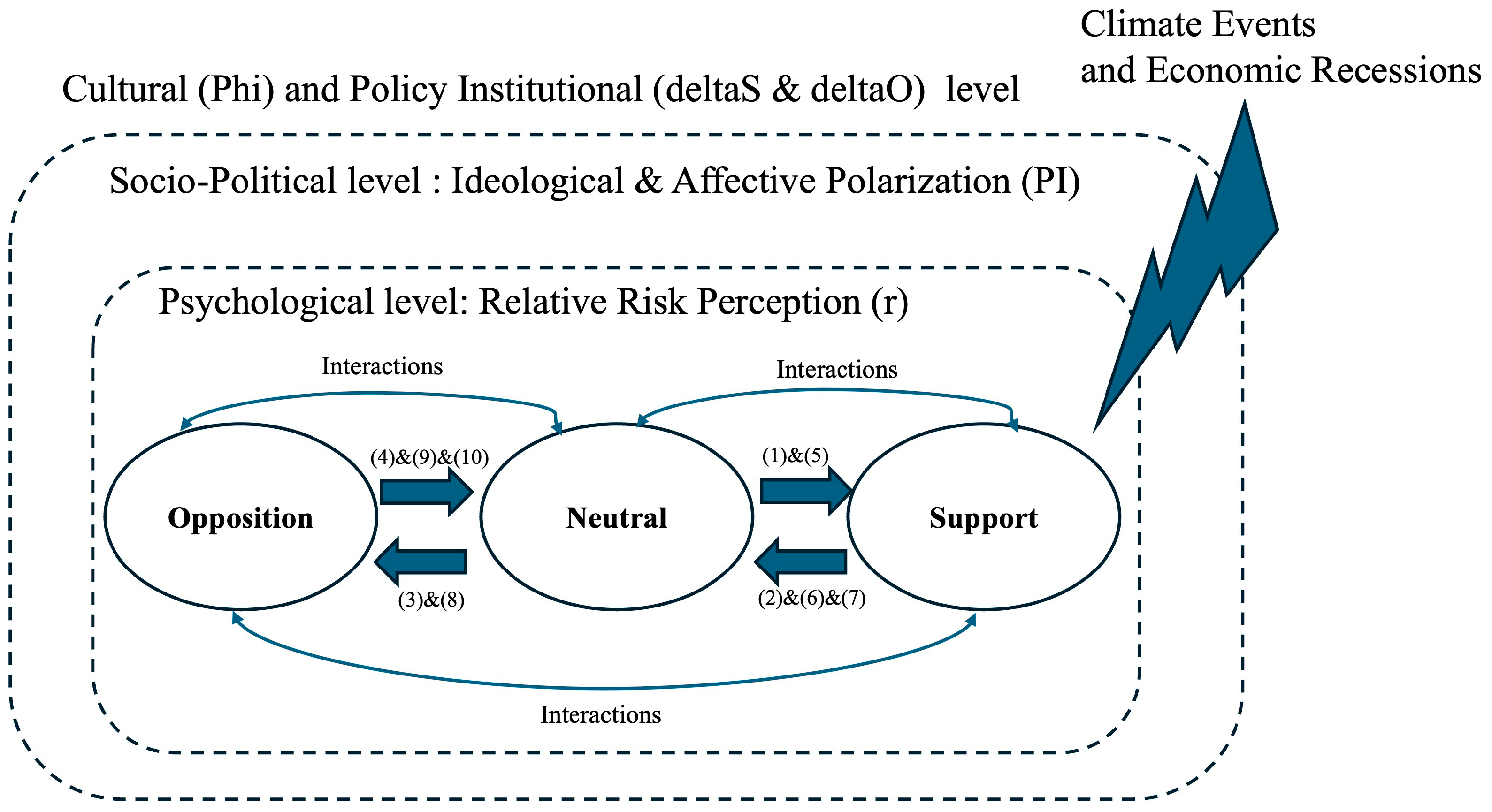
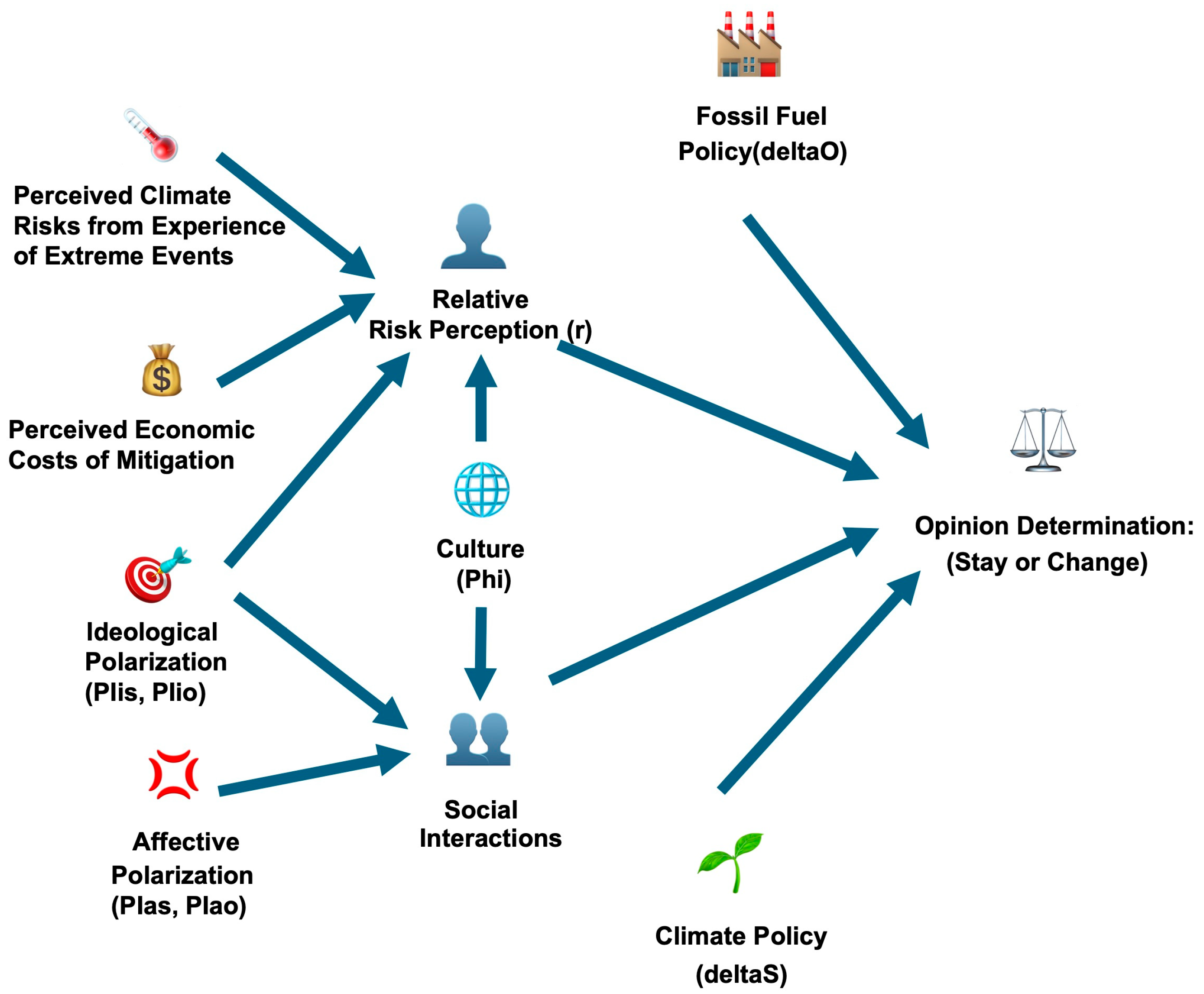

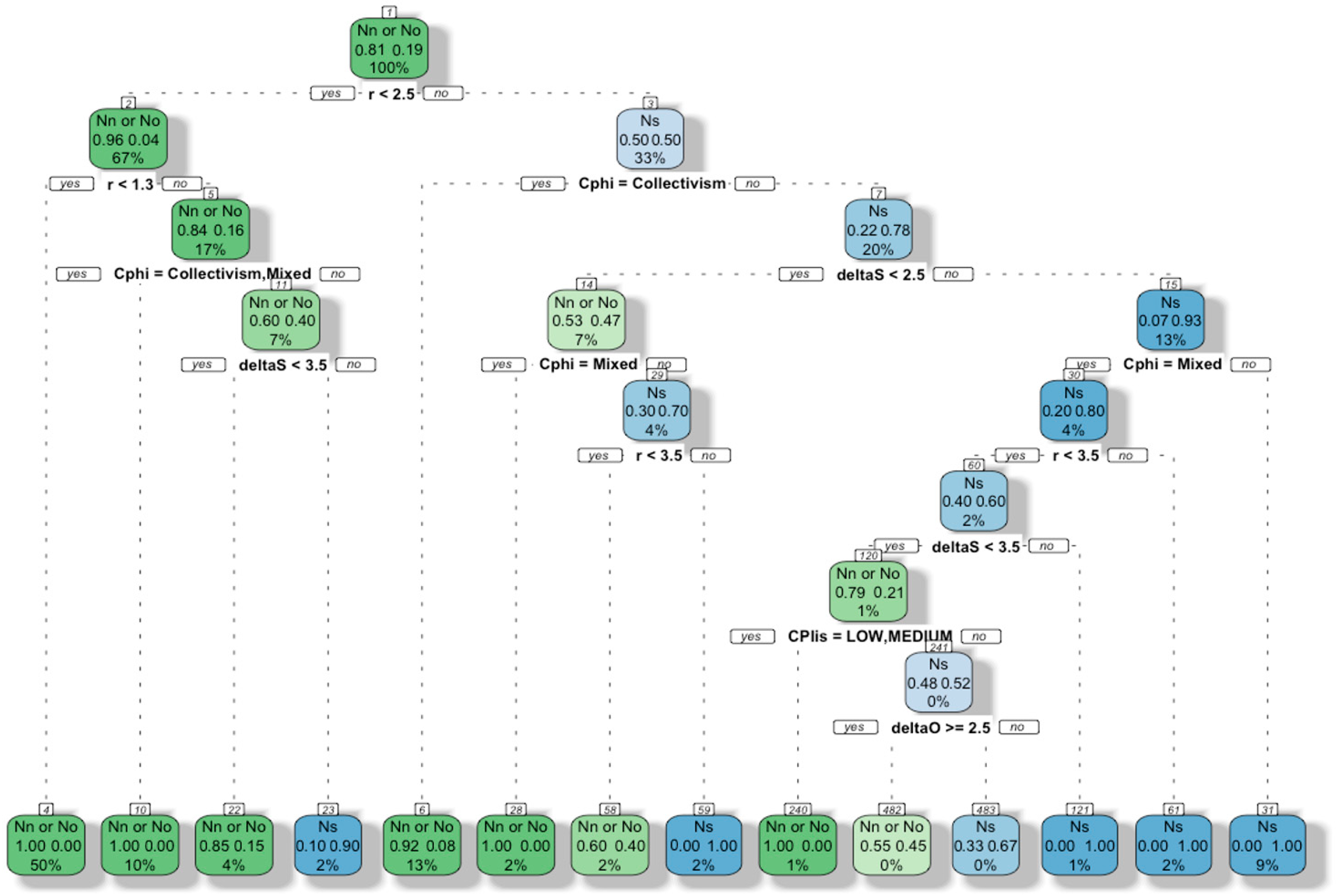
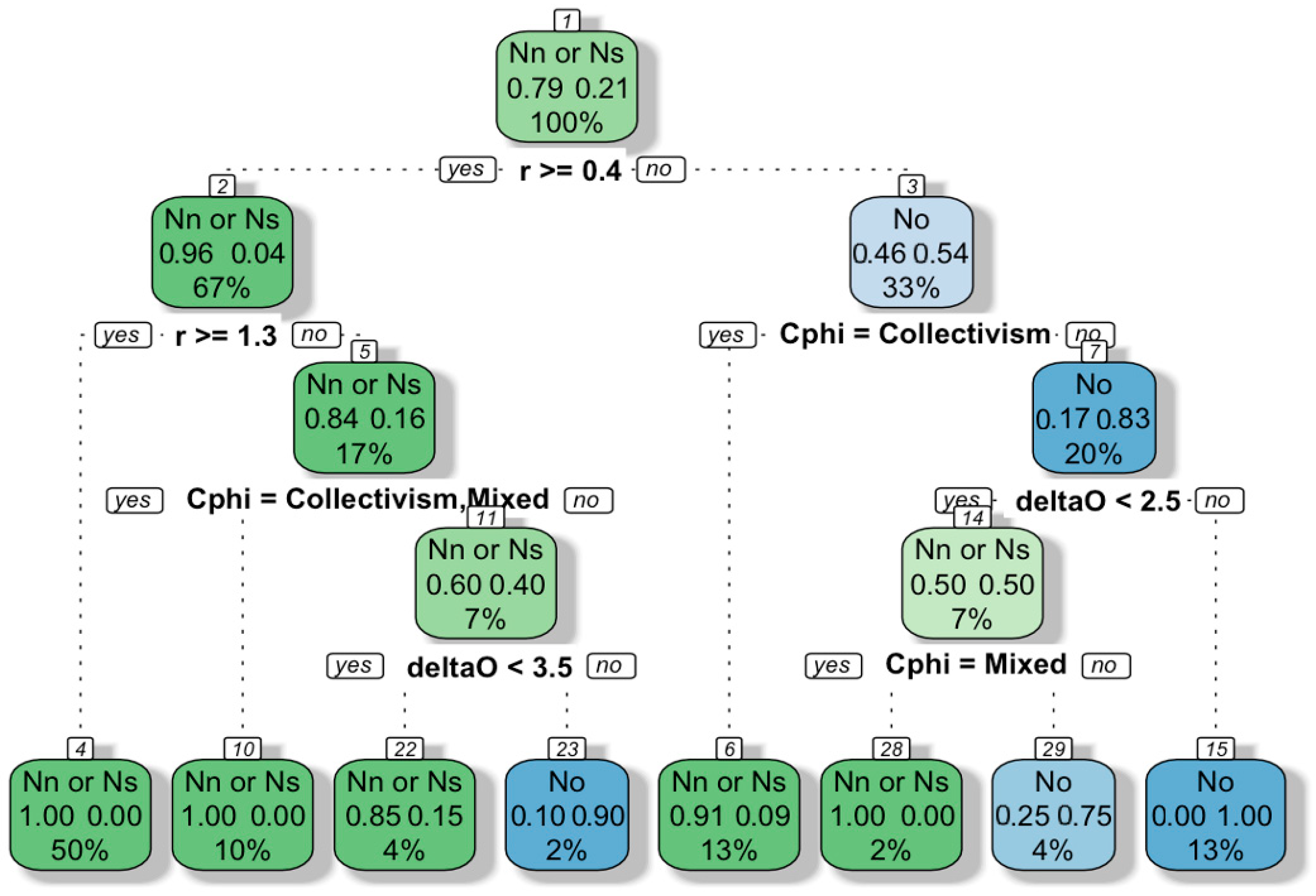
| Variables/ Parameters | Definition | Range | Unit |
|---|---|---|---|
| Ns | Fraction in the support group | Between 0–1 | Dimensionless |
| No | Fraction in the opposition group | Between 0–1 | Dimensionless |
| Nn = 1 − Ns − No | Fraction in the neutral group | Between 0–1 | Dimensionless |
| r | Relative risk perception: Ratio of perceived severity of climate impacts (perceived climate risk) to perceived economic costs of mitigation (perceived economic risk) for the neutral group | No limit | Dimensionless |
| Rho | Rate at which a group is amenable to changing opinion (fraction per unit time) | 0.2 | 1/Time |
| PIis and PIio | Ideological polarization of support and opposition groups | Between 0–1 | Dimensionless |
| Variables/ Parameters | Definition | Range | Unit |
|---|---|---|---|
| Beta | The fraction of interactions needed to change one’s opinion | 0.15 | 1/Time |
| PIas and PIao | Support group and opposition groups’ affective polarization | Between 0–1 | Dimensionless |
| deltaS and deltaO | Effectiveness of climate policies (deltaS) and fossil fuel policies (deltaO) in maintaining opinion group membership. Larger values indicate a stronger policy that causes individuals to remain longer in their respective opinion groups, independent of other model factors. | 2, 3 or 4 | Time |
| Cultural Type | Climate Risk Threshold | Policy Benefit Requirements | Opinion Change Likelihood |
|---|---|---|---|
| Individualistic | Moderate relative risk perception (r ≥ 2.5) | Policy benefits are required only when relative risk perception is not sufficient. | High (Responsive to evidence) |
| Mixed | High relative risk perception (r ≥ 3.5) | Requires highly effective policies (either deltaS or deltaO ≥ 3.5) | Moderate (Conditional response) |
| Collectivistic | Relative risk perception does not affect opinion | Policy effectiveness insufficient to overcome dominant social norms | Low (Stable dominant opinions) |
Disclaimer/Publisher’s Note: The statements, opinions and data contained in all publications are solely those of the individual author(s) and contributor(s) and not of MDPI and/or the editor(s). MDPI and/or the editor(s) disclaim responsibility for any injury to people or property resulting from any ideas, methods, instructions or products referred to in the content. |
© 2025 by the authors. Licensee MDPI, Basel, Switzerland. This article is an open access article distributed under the terms and conditions of the Creative Commons Attribution (CC BY) license (https://creativecommons.org/licenses/by/4.0/).
Share and Cite
Shin, Y.A.; Constantino, S.M.; Gross, L.J.; Kinzig, A.; Lacasse, K.; Beckage, B. Culture Mediates Climate Opinion Change: A System Dynamics Model of Risk Perception, Polarization, and Policy Effectiveness. Climate 2025, 13, 194. https://doi.org/10.3390/cli13090194
Shin YA, Constantino SM, Gross LJ, Kinzig A, Lacasse K, Beckage B. Culture Mediates Climate Opinion Change: A System Dynamics Model of Risk Perception, Polarization, and Policy Effectiveness. Climate. 2025; 13(9):194. https://doi.org/10.3390/cli13090194
Chicago/Turabian StyleShin, Yoon Ah, Sara M. Constantino, Louis J. Gross, Ann Kinzig, Katherine Lacasse, and Brian Beckage. 2025. "Culture Mediates Climate Opinion Change: A System Dynamics Model of Risk Perception, Polarization, and Policy Effectiveness" Climate 13, no. 9: 194. https://doi.org/10.3390/cli13090194
APA StyleShin, Y. A., Constantino, S. M., Gross, L. J., Kinzig, A., Lacasse, K., & Beckage, B. (2025). Culture Mediates Climate Opinion Change: A System Dynamics Model of Risk Perception, Polarization, and Policy Effectiveness. Climate, 13(9), 194. https://doi.org/10.3390/cli13090194






